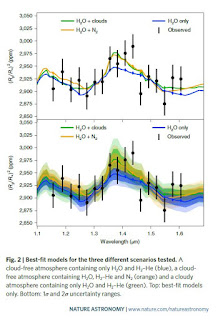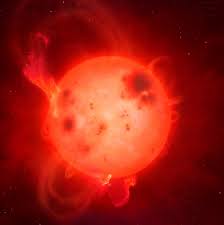A recent issue of Nature Astronomy reported on a detection
of a watery super-earth in the habitable zone of a nearby M-Class star, in a
paper entitled “Water vapour in the
atmosphere of the habitable-zone eight-Earth-mass planet K2-18b”. This is a very interesting discovery, the
first of its kind, but likely we will hear more and more about finds of this
type in the future, as the observational technology steadily improves.
The interesting features of the detection are included in
the title of the paper – water, habitable zone, eight-Earth mass. These are all thought to be necessary (though
not sufficient) for the development of life, as we know it. So, let’s break down the title of the paper further,
to explore the significance of each phrase in the title:
Water
vapour
in the atmosphere of the habitable-zone eight-Earth-mass planet K2-18b
Water is now known to be extremely common, throughout the
universe. It has been found on many
planets of our solar system (ice, liquid or vapour), in galactic molecular
clouds, and in stellar atmospheres. Water
is essential for life as we know it, due to its peculiar chemical properties,
which render it an excellent solvent, that supports the cellular activities of
living things. In the search for
extra-terrestrial life, NASA and other agencies of this type have emphasized
the strategy “follow the water”.
Water vapour
In
the atmosphere
of the habitable-zone eight-Earth-mass planet K2-18b
In the case of this
detection, the water was discovered in vapour form, during a series of transits
of the star that it orbits. These
observations were made by the Hubble Space Telescope, which orbits Earth. As the planet passes in front of the star
(transits) from the Earth’s perspective, the light of the star dims and the spectrum
of light changes. Some light will
actually pass through the planet’s atmosphere, altering the spectrum because of
certain quantum effects, which leaves behind a fingerprint of the types of gases
found in that atmosphere.
The modelling detected a statistically significant signal
indicating that there was an atmosphere around K2-18b i.e. the spectrum differed
from a flat spectrum (a model with no active gases) at better than 3 standard
deviations. This in itself was
important, as it was the first time an atmosphere had been detected around a “super-Earth”
with a high level of statistical significance.
The observed spectrum
was then compared to a synthetic spectrum of how light would be expected to be
altered, as it passed through an atmosphere with a typical range of gases in
the observed wavelengths, or potential absorbers, in the language of spectral
analysis. These gases included water
vapour (H2O), carbon monoxide (CO), carbon dioxide (CO2), methane (CH4), and
ammonia (NH3). Hydrogen (H2), Helium (He) and Nitrogen (N2) were
also modelled as possible constituents.
The strength of the match between the observed spectrum and
the various synthetic spectrums was computed, via statistical “best fit”
modelling. The candidates that best
matched the observed spectra were:
·
a cloud-free atmosphere of H2O and H2-He.
·
a cloud-free atmosphere of H2O and H2-He, as
well as molecular nitrogen.
·
a cloudy atmosphere of H2O and H2-He.
All of these models indicated that water vapour was in the
atmosphere, with high statistical confidence.
However, none of the models was clearly superior to the others, though
the cloud-free H2O and H2-He model was somewhat favoured. If that is the case, it would yield an
atmosphere with some 30% to 50% water vapour.
There may be other trace gases as well.
Water vapour In the
atmosphere
of the Habitable Zone
eight-Earth-mass planet K2-18b
The habitable zone of a star is defined as that region that
is far enough away from the star to allow liquid water to exist on the surface,
but not so far that all water would become frozen as ice. That’s because liquid water is needed to
carry on the life processes of cells.
The exact range of orbital
distances that are within in the habitable zone depend on the type of star (mainly
size and temperature) as well as certain features of the planet (mainly albedo
or reflectivity and greenhouse effect).
Bigger stars are hotter, so their habitable zones are farther out than
is the case for smaller stars. The
temperature of a star is measurable via its spectrum (where the spectrum peaks).
Planets with high albedos will reflect a lot of incoming
light, while those with low albedos will absorb a lot of light. So, a planet that has a has a high albedo will
have to be closer to its star, to sustain liquid water. As to the greenhouse effect, a planet with an
atmosphere with a lot of greenhouse gases can be farther from its star, and
still sustain liquid water. Features of
a distant planet, such as albedo and greenhouse gas composition are much more
difficult to measure.
Obviously, these factors (and many more, such as the
existence of plate tectonics) will interact over a short and long term basis,
making the precise distance of the habitable zone difficult to estimate. That’s also why modelling the Earth’s climate
is difficult.
Water vapour In the
atmosphere of the
Habitable Zone
eight-Earth-mass planet K2-18b
Planets can be grouped into various classes, such as:
·
Terrestrial (rocky, smaller and similar in size
to Earth).
·
Super-Earth (rocky, up to ten Earth masses).
·
Mini-Neptunes (over ten Earth masses, up to
Neptune size, rocky core, thick gas atmosphere.
·
Gas giants (really big planets, such as the out
planets of our solar system, such as Jupiter and larger)
This
particular planet, K2-18b is thought to be about 8 Earth masses, and around 2.3
Earth radii. That gives it a density 3.3
g/cm3, which compares to Earth’s density of about 5.5. The lower density would imply a rocky planet,
but with a substantial atmosphere, or perhaps a very substantial water ocean (a
water world).
Given its
orbital distance from its star (about 1.4 astronomical units or about 200,000
km) its temperature is probably between 200 and 320 degrees Kelvin. The freezing point of water is about 273
Kelvin and the boiling point is about 373, so there is a good chance that the
planet’s temperature might be suitable for life as we know it. The finding of
substantial water vapour in the atmosphere might imply a rather steamy water
world.
The star that it is
circling is much smaller than the sun, of the class M2.5, also known as a red
dwarf. It is substantially cooler than
our sun at about 3500 K, whereas our sun is at about 5800 K. Since it is cooler, the habitable zone is
much closer to the star, so the planet in question in the habitable zone for that
star.
There has
been a lot of conjecture about whether M-class stars are suitable for life, as
these stars give off frequent bursts of energetic radiation, via flares. These flares might effectively sterilize the
surface of any planet in orbit around such a star, or strip it of its
atmosphere.
Also,
there is a greater tendency for planets orbiting such a star in the habitable
zone to become tidally locked over time, similar to how the moon is tidally
locked to the Earth. That would result
in one side of the star being intolerably hot, with other side being freezing
cold.
The very
fact that these are “red” dwarfs indicate that the radiation peaks at a less
energetic level than does the sun’s radiation.
That means less energy for photosynthesis, which would inhibit life.
However, there
has been some re-thinking of these issues.
For example, red dwarf flares may not be as dangerous as once thought,
especially as the star ages. As for
tidal locking, it might result in crazy weather, but an atmosphere and ocean
might well redistribute heat well enough for life to take hold.
Finally, it is quite possible that plants
would evolve to make use of less energetic sunlight. These issues are explored in
the blog and paper cited below.
And, let’s not forget that life has been found on a Red Dwarf, namely the British
comedy SF series, Red Dwarf.
It should
also be noted that this star is only about 124 or so light years from the Earth
(about 38 parsecs). That’s a long way
off in human terms, but in galactic terms (about 10,000 light years across the
galaxy), that’s just about next door.
The distance still makes visiting a dream for some far-flung future, but
it will make close observation possible, especially as larger and more accurate
space telescopes are launched. So, I
think it is fair to say that this is “in the neighborhood”.
This ties
into some of the recent objections to calling this planet a Super-Earth, rather
than a mini-Neptune. If it is the
latter, then it would seem to be a much less interesting discovery. But, at present, nobody can be sure, as the
observational science is far from clear-cut.
Time, and more observations with increasingly better instruments, will
tell.
Sources:
1 – Nature Astronomy paper
Water vapour in the
atmosphere of the habitable-zone eight-Earth-mass planet K2-18 b, Angelos
Tsiaras, Ingo P.
Waldmann, Giovanna
Tinetti, Jonathan
Tennyson & Sergey N.
Yurchenko, Nature Astronomy (2019).
2 – Life and Red Dwarf Stars
3 – Red Dwarfs and Photosynthesis
The Potential of
planets orbiting red dwarf stars to support oxygenic photosynthesis and complex
life. Joseph Gale and Amri Wandel,
International Journal of Astrobiology, 16(1): 1-9 (2017)
-----------------------------------------------------------------------------------------------------------------
Now that you have read some real science (astronomy and astrophysics), you
should read some science fiction. The
Witch’s Stones series would be an excellent choice. Alternatively, you could try the short story
“The Magnetic Anomaly”, a SF story which includes plenty of interesting
geophysics, including magnetic fields.
The Witches’ Stones
Or, you might prefer, the trilogy of the Witches’ Stones
(they’re psychic aliens, not actual witches), which follows the interactions of
a future Earth confederation, an opposing galactic power, and the Witches of
Kordea. It features Sarah Mackenzie,
another feisty young Earth woman (they’re the most interesting type – the
novelist who wrote the books is pretty feisty, too).
The Magnetic Anomaly: A Science Fiction Story
“A geophysical crew went into the Canadian north. There were
some regrettable accidents among a few ex-military who had become geophysical
contractors after their service in the forces. A young man and young woman went
temporarily mad from the stress of seeing that. They imagined things, terrible
things. But both are known to have vivid imaginations; we have childhood
records to verify that. It was all very sad. That’s the official story.”









No comments:
Post a Comment